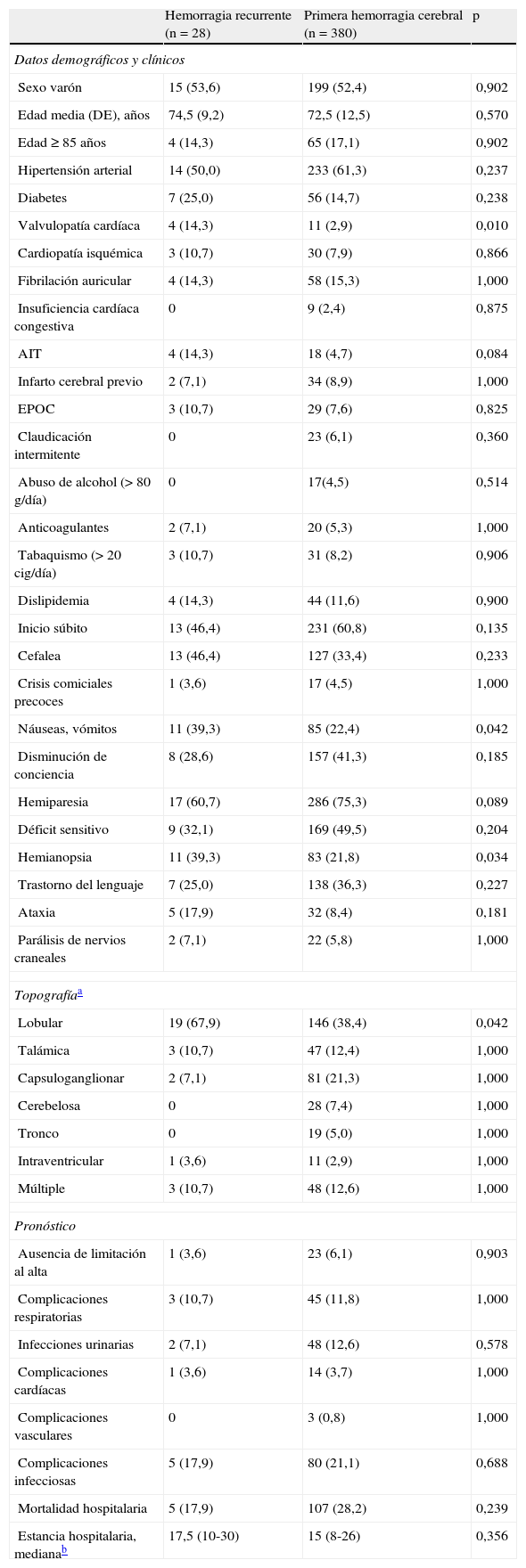Analizar las características demográficas, pronósticas y el perfil clínico relacionado con las hemorragias intracerebrales no traumáticas recurrentes (HCR).
Pacientes y métodoEstudio hospitalario descriptivo de 28 pacientes consecutivos ingresados durante un período de 19 años por presentar HCR. Se efectúa una comparación con 380 pacientes con una primera hemorragia intracerebral no traumática.
ResultadosLas HCR representan el 6,8% del total de hemorragias intracerebrales primarias. Las HCR fueron mayoritariamente lobulares (67,9%). Otras topografías incluyen: el talámo (10,7%), la región capsuloganglionar (7,1%), la zona intraventricular (3,6%) y la topografía múltiple (10,7%). Aunque las HCR tienen mal pronóstico evolutivo, este no es peor en comparación con el de las primeras hemorragias cerebrales primarias, tanto por su elevada mortalidad hospitalaria (17,9 frente al 28,2%), como por su baja frecuencia de ausencia de limitación al alta hospitalaria (3,6 frente al 6,1%). El perfil clínico significativamente asociado con las HCR fue: presencia de valvulopatía (odds ratio [OR] 5,32; intervalo de confianza del 95% [IC 95%] 1,45-19,47), la topografía lobular (OR 3,53; IC 95% 1,53-8,13) y la presencia de náuseas y vómitos (OR 2,43; IC 95% 1,06-5,52).
ConclusionesLas HCR constituyen menos de una décima parte de las hemorragias intracerebrales no traumáticas ingresadas en el Servicio de Neurología, siendo más frecuentes las localizadas en los lóbulos cerebrales. Aunque su pronóstico es grave, este no es peor -durante su fase aguda- que el de las primeras hemorragias intracerebrales. Las HCR presentan un perfil clínico propio y diferenciado.
To characterize the clinical factors and prognosis and identify determinants of hemorrhage recurrence (HCR) in patients with acute non-traumatic intracerebral hemorrhage.
Patients and methodStroke patterns were studied in 28 consecutive recurrent non-traumatic intracerebral hemorrhage patients admitted to the Department of Neurology of the Sagrat Cor Hospital of Barcelona for a 19 year period. Demographic, risk factors, clinical, neuroimaging and outcome variables were analyzed and compared with patients with first-ever non-traumatic intracerebral hemorrhage (n=380) to identify predictors of hemorrhage recurrence. Significant variables were entered into a multivariate logistic regression analysis.
ResultsHCR accounted for 6.8% of all patients with acute consecutive non-traumatic intracerebral hemorrhages. The HCR were mostly lobar (67.9%). Other topographies include: thalamus (10.7%), capsule-ganglionar (7.1%), intraventricular (3.6%) and multiple topographies (10.7%). Although the HCR have poor prognosis, it is not worse compared to the first-ever intracerebral hemorrhages, both at the high hospital mortality (17.9 vs. 28.2%) as the low frequency of absence of limitation at discharge (3.6 vs. 6.1%). The clinical profile significantly associated with HCR was: valvular heart disease (odds ratio [OR] 5.32; 95% confidence interval [95% CI] 1.45-19.47), lobar topography (OR 3.53, 95% IC 1.53-8.13), and the presence of nausea and vomiting (OR 2.43, 95% IC 1.06-5.52).
ConclusionsHCR constitute less than one tenth of non-traumatic intracerebral hemorrhages and are most commonly located in the brain lobes. Although the prognosis is serious, this is no worse during the acute phase, than of the first-ever non-traumatic intracerebral hemorrhages. Clinical profiles were different in recurrent non-traumatic intracerebral hemorrhage patients when compared to first-ever non-traumatic intracerebral hemorrhage patients.
Artículo
Comprando el artículo el PDF del mismo podrá ser descargado
Precio 19,34 €
Comprar ahora








